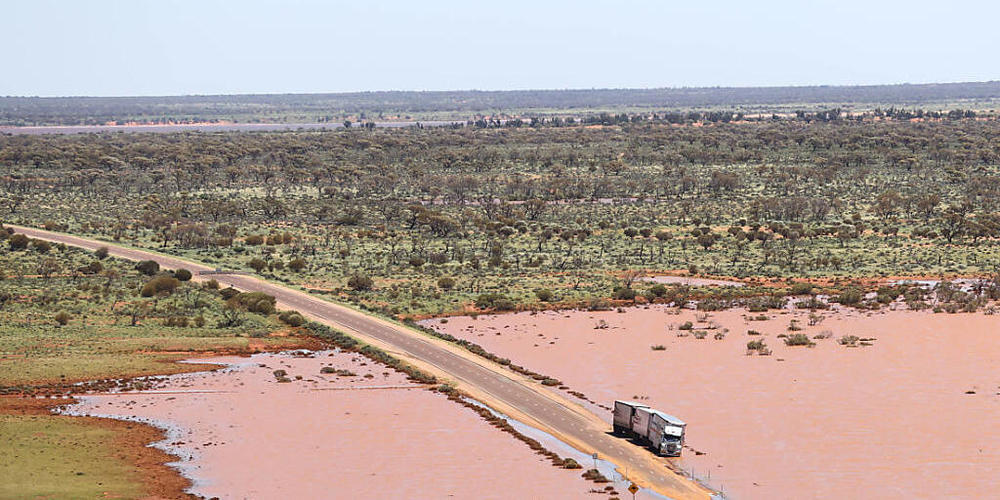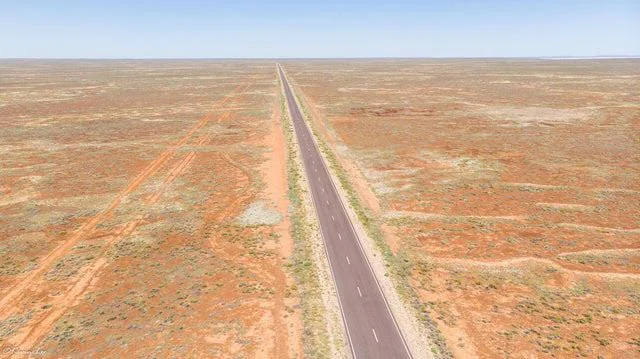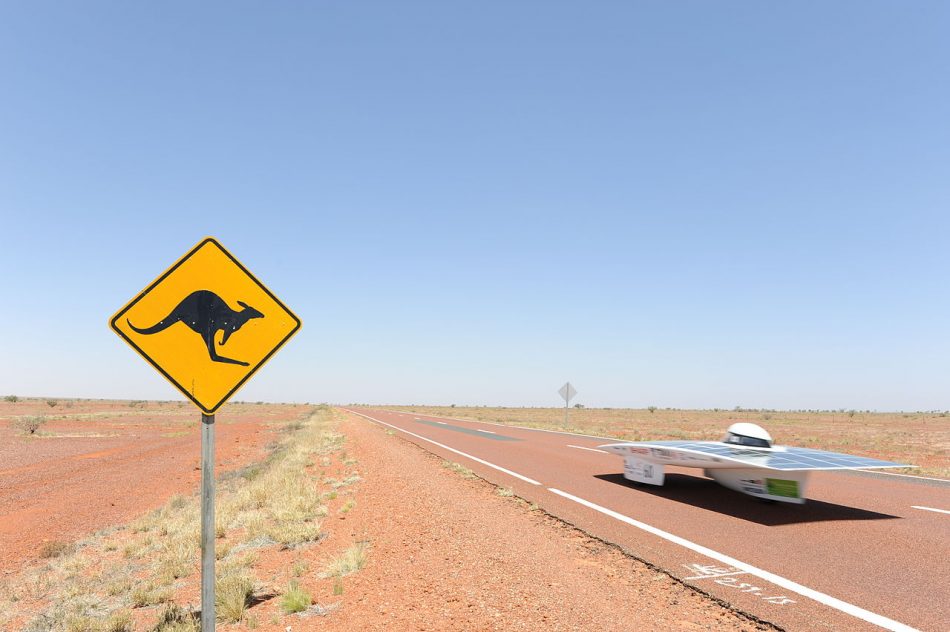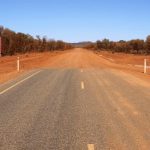The Stuart Highway, affectionately known as “The Track,” is a vital artery traversing the vast Australian Outback, from North to South. It connects the Northern Territory’s Darwin to South Australia’s Port Augusta. This iconic route, spanning an impressive 2,720 kilometers (1,690 miles), is a symbol of Australia’s pioneering spirit and a gateway to the country’s remote and captivating interior.
| Country | Australia |
| North and South end | Darwin and Port Augusta |
| Type of road | Highway |
| How Long is the Stuart Highway? | 2,720 km (1,690 mi) |
Route and Landmarks
The Stuart Highway winds its way through the heart of Australia’s Outback, showcasing the region’s diverse landscapes and cultural heritage. Along the way, travelers encounter iconic landmarks such as the Katherine Gorge, Daly Waters Hotel, Tennant Creek, Alice Springs, and Coober Pedy, a subterranean town nestled amidst opal fields.

Flood waters are seen where the Sturt Highway has been cut off near Glendambo, 2022
Remember, when embarking on a road trip along Stuart Highway, it’s not just a drive; it’s an adventure through Australia’s heart and soul.
Key Attractions
The Stuart Highway offers a wealth of natural wonders and cultural experiences, catering to a wide range of interests. Highlights include:
- Katherine Gorge: This spectacular sandstone gorge system offers opportunities for swimming, canoeing, and hiking.
- Daly Waters Hotel: A classic Outback watering hole, known for its annual bar crawl and the Daly Waters Pub Rally.
- Tennant Creek: A vibrant town with a rich history of gold mining and Aboriginal culture.
- Alice Springs: The heart of the Northern Territory, known for its cultural attractions, including the Australian Red Centre Desert Knowledge Precinct and the Alice Springs Desert Park.
- Coober Pedy: An extraordinary town where over 70% of the population lives underground, taking refuge from the harsh desert climate. Coober Pedy is a unique town in South Australia known for its underground houses, opal mining, and desert landscapes. It’s a popular tourist destination for those seeking an outback adventure.
- Uluru-Kata Tjuta National Park is a protected area in the Northern Territory of Australia. The park is home to two of Australia’s most iconic natural landmarks: Uluru (Ayers Rock) and Kata Tjuta (The Olgas). Uluru is a monolithic rock formation that rises 348 meters (1,142 feet) above the surrounding plain. It is the largest monolith in the world and is considered sacred by the Anangu Aboriginal people, who have lived in the region for thousands of years. Kata Tjuta is a group of 36 sandstone domes that rise up to 546 meters (1,792 feet) above the plain.
- Go wildlife watching for kangaroos, emus, and a variety of other animals.
- Indulkana and Kulgera are two outback towns in South Australia that are home to some of the most impressive Aboriginal rock art in the country. The rock art at these sites dates back thousands of years and depicts the stories, traditions, and culture of the Anangu people, the traditional owners of the land.
Driving the Stuart Highway
The Stuart Highway is a challenging route, requiring careful planning and preparation. It’s essential to ensure your vehicle is in good condition and has a full tank of fuel. Carry plenty of water, food, and essential supplies, and be prepared for extreme weather conditions, including high temperatures, dust storms, and heavy rains.

Tips for an Enduring Journey & Drive, to fully appreciate the Stuart Highway’s unique charm, consider these tips:
- Take your time: Allow ample time for rest and exploration along the way.
- Embrace the Outback atmosphere: Immerse yourself in the solitude and beauty of the Australian Outback.
- Respect the environment: Leave no trace and be mindful of the fragile ecosystem.
- Support local communities: Patronize local businesses and support the resilience of Outback communities.
- Document your journey: Capture the memories with photos, videos, and written accounts.
This is the advice of the Australian Reddit user alstom_888m:
- If you hit a cow or camel, you die. If your car breaks down, you die. Watch out for wildlife, an animal strike will likely destroy your vehicle. If you hit a kangaroo mid-jump they may go through your windscreen. Likewise with a wedge tail eagle feeding a carcass on the road, their take off is too slow to avoid a car at 110.
- Road trains can see a lot further than you can. They should be restricted to 100 but many operators disable the governor. A professional driver will help you overtake by flashing his indicator to let you know the way ahead is clear, accelerate you car to around 130-140 and get ahead as quick as possible. Get well ahead (around a “carriage” length) before cutting back in into the left lane. Do not leave them no space. They will NOT disengage the cruise control for any reason other than a fire emergency and if he meets you at the next servo he will likely confront you.
- Highway patrol do patrol up and down the road, they generally don’t set up speed radar traps but will book you if you are speeding by a dangerous margin. The speed limit in SA is 110. In NT it is 130 but will go down to 100 around 10km either side of a town.
- If you drive to Uluru the Lasseter Highway is sealed but narrow. The speed limit is 110 and that’s too fast in some sections. Trucks and Large Tour Coaches will take up more than their lane especially as many of the tour coach drivers are inexperienced (that’s why they are out there). So watch out.
- Do not drive at night or within an hour of sunrise and sunset. This is when all wildlife is most active, you have a chance of hitting kangaroos, goats, sheep, emus or pigs.
- Fill up at EVERY service station. It will be at least 100km to the next one and the price is only going up. The largest gap I recall is between Glendambo and Coober Pedy around 280km. Carry at least one 20L jerry can. Two is even better.
- Learn how to change a tire.
- Mobile Phone reception is not everywhere. You may not be able to call the RAA (SA) or AANT (NT).
- The food is terrible at Marla and the locals (from the APY lands) are quite intimidating which is unlike encounters I’ve had with the Anangu (Aboriginal people of Central Australia), it could be more to do with their relationship with the residents of Marla.
- I definitely recommend getting a camel burger at Kulgera.
Stuart Highway Speed Limit 2024
The Stuart Highway was once known for having no speed limit in some sections of the Northern Territory. This was due to the vast distances between towns and the minimal police presence in the area.
However, in 2007, the Northern Territory government decided to introduce a speed limit of 130 kilometers per hour (80 miles per hour) on all roads, including the Stuart Highway. This decision was made in an effort to improve road safety. So, the Stuart Highway Speed Limit 2024 is 130 kilometers per hour (80 miles per hour).
The speed limit on the Stuart Highway in South Australia is 110 kilometers per hour (68 miles per hour). This limit is in place to protect the safety of both drivers and animals. The highway is home to a variety of wildlife, including kangaroos, camels, and emus. These animals can often be seen crossing the road, and drivers need to be prepared to slow down or stop to avoid a collision.
While there is no longer an unlimited speed limit on the Stuart Highway, it is still a challenging route to drive. The highway is often very remote, and there are few places to stop for fuel or supplies. Drivers should always be prepared for emergencies and should carry plenty of water and food.
Historical Significance
The Stuart Highway’s origins trace back to the efforts of Scottish explorer John McDouall Stuart, who made three expeditions between 1862 and 1864, becoming the first European to cross Australia from south to north. His route, known as the Overland Telegraph Route, laid the foundation for the modern-day Stuart Highway.


 (3 votes, average: 4.67 out of 5)
(3 votes, average: 4.67 out of 5)











